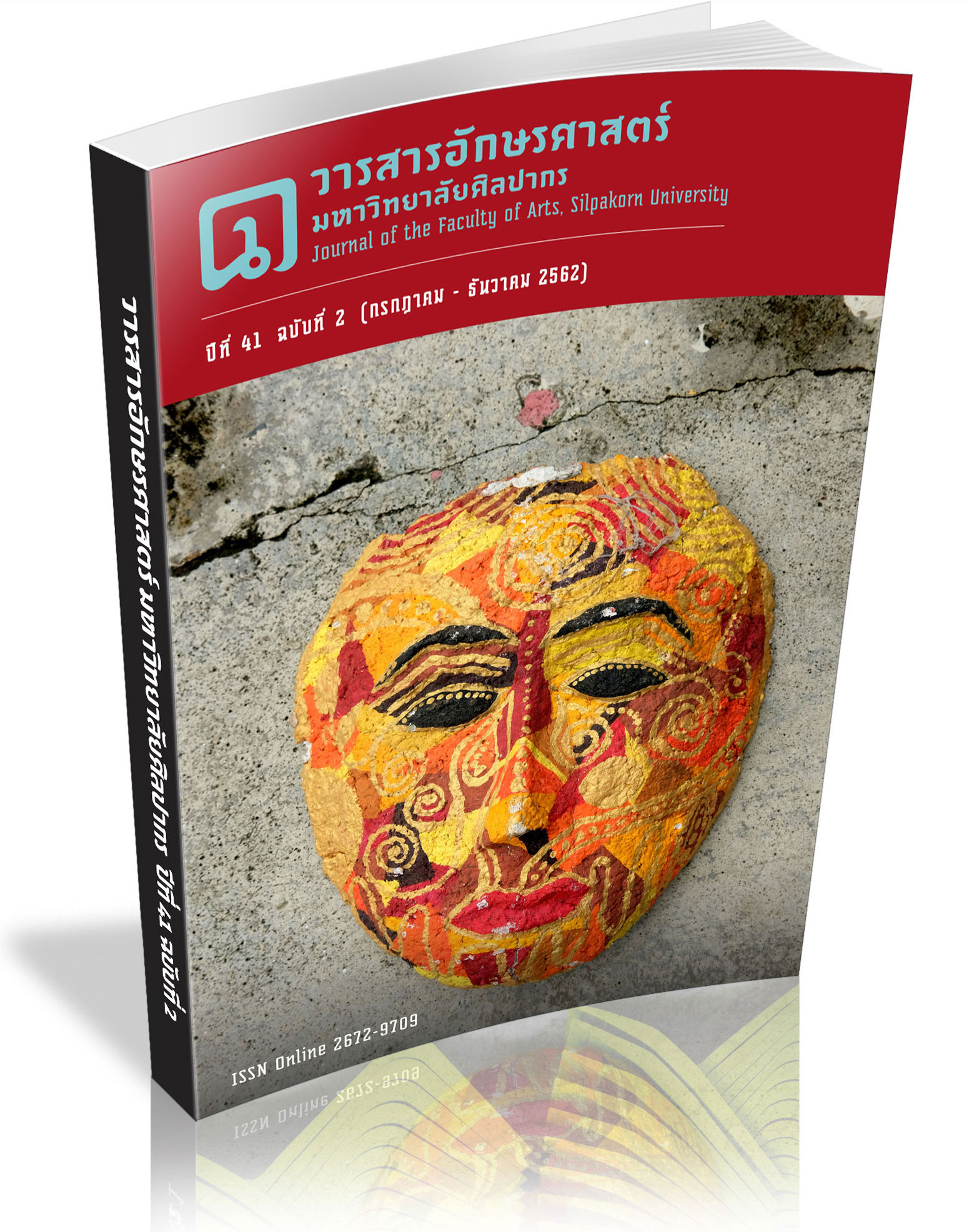Royal Decree Discourse
A Case study of the Royal Decrees in the Thonburi and the Rattanakosin Periods, the Reign of King Rama I to the Reign of King Rama III
Keywords:
Royal decree, Discourse, StyleAbstract
This article aims to analyze the structure, content, and style in the 412 royal decrees written in the Thonburi and the Rattanakosin periods, during the reign of King Rama I to the reign of King Rama III. The results showed that the royal decree discourse can be divided into four structural compositions: special information, introduction, content, and the ending. The content indicated the monarch obligations that can be categorized into two main types: royal ceremonies, and official regulations. Furthermore, this study showed four main aspects regarding style. First, word, there are six kinds of word usage: royal words, address terms, directive terms, informing sequence terms, adding detail terms, and synonyms. Second, there are two kinds of sentence forms: imperative sentences, and rational sentences. Third, there are two kinds of literary devices: trope and rhyme. Fourth, there are two kinds of writing styles: narration and description. The structure, content and style can be exposed the characteristic of the royal decrees in the Thonburi and the Rattanakosin periods, revealed that royal decree discourse is a behavioral discourse that may appear a expository discourse.
Downloads
References
Burutpat, S. (1994). Discourse Analysis. 2nd ed. Bangkok: Research Institute for Languages and Cultures of Asia, Mahidol University. (In Thai)
Chularatana, J. (2001). The Krom Tha Khwa Officials: Their Roles and Functions during the Ayutthaya and Ratanakosin Periods (1610-1892). Doctoral Dissertation, Department of History, Chulalongkorn University. (In Thai)
Damrong Rajanubhab, Prince. (1950). Book of Tradition in the Royal Court of the Reign of Ayutthaya Period and the Criticism of Prince Damrong Rajanubhab. Phra Nakorn: Phrachan. (The Cremation Book of Princess Phrapapanpilai, Sanam Luang Ceremonial Ground, 1950 A.D.) (In Thai)
Dhanvarjor, R. (1991). A Study of Lexical Reduplication in Thai. Doctoral Dissertation, Department of Thai, Chulalongkorn University. (In Thai)
Jaratjarungkiat, D. (2000). Discourse Connectors in Thai from the Sukhothai Period to the Present. Doctoral Dissertation, Department of Thai, Chulalongkorn University. (In Thai)
Jaratjarungkiat, S. (2008). /jaŋ/: A Diachronic Study. Master Thesis, Department of Thai, Chulalongkorn University. (In Thai)
Laksanasiri, J. & Imsamran, B. (2005). Language and Communication. Nakhon Pathom: Faculty of Arts, Silpakorn University. (In Thai)
Longacre, R. E. (1996). The Grammar of Discourse. 2nd Ed. New York: Plenum Press.
Mahakan, P. (1981). History of Thai Government. Chonburi: Faculty of Social Sciences, Srinakharinwirot Univeristy, Bangsaen Campus. (In Thai)
Na Nakorn, P. (1967). Writing: Prose and Style. In Lecture of Advanced Thai. Bangkok: Kurusapa. (In Thai)
Na Nakorn, P. (1992). Art of Writing. Bangkok: Kawfang. (In Thai)Nitmai, P. (2007). Tattoo: Establishment of Identity as Self-Identifying on the Body. (Independent study), Chiangmai University. (In Thai)
Office of the Royal Society. (2017). Dictionary of Linguistics, Version of Office of the Royal Society. Bangkok: A-Biz Intergroup. (In Thai)
Panpothong, N. (2012). Lecture of Pragmatics and Analysis of the Thai language. Bangkok: Department of Thai, Faculty of Arts, Chulalongkorn University. (In Thai)
Panpothong, N. (2013). Critical Discourse Analysis: Concept and Approach to Thai Discourse Analysis. Bangkok: Faculty of Arts, Chulalongkorn University. (In Thai)
Panthayangkun, Y. et al. (1980). The Royal Decrees, Part 1, the Reign of Thonburi Period. Bangkok: The committee for the Consideration and the Publishing of Papers on History, Office of the Prime Minister. (In Thai)
Panthayangkun, Y. et al. (1982). The Royal Decrees, Part 2, the Reign of Rattanakosin Period. Bangkok: The committee for the Consideration and the Publishing of Papers on History, Office of the Prime Minister. (In Thai)
Panthayangkun, Y. et al. (1985). The Royal Decrees, Part 3, the Reign of King Rama II of the Rattanakosin Period. Bangkok: The committee for the Consideration and the Publishing of Papers on History, Office of the Prime Minister. (In Thai)
Panthumetha, N. (2011). Thai grammar. 6th ed. Bangkok: Faculty of Arts, Chulalongkorn University. (In Thai)
Paraprasert, N. (2002). Thai Politics in the Lower Chao Phraya Basin from the Period of Twin Cities to the Period of kingdoms: A Case Study of the Development of Ayutthaya and Early Bangkok Palaces. Master Thesis, Department of History, Chulalongkorn
University. (In Thai)
Rodsub, N. (2011). Personal Reference Terms in Thai royal palace from the study of H.R.H. Prince Maha Vajirunahisa’s Diary. HCU Journal, 14(28) : 23-39. (In Thai)
Rothtong, U. (1999). Derivation of Disyllabic Synonymous Compounds. Master Thesis, Department of Oriental Language, Silpakorn University. (In Thai)
Royal Institute. (2010). Dictionary of Applied Linguistics, Version of Royal Institute. Bangkok: Rungsilp Printing. (In Thai)
Satavetin, J. (1967). Writing: Prose and Individual Style. In Lecture of Advanced Thai. Bangkok: Kurusapa. (In Thai)
Teekhachunhatean, R. (2006). Lanna Traditional Medicine Texts: A Stylistic Study. Bangkok: Chulalongkorn University. (In Thai)
Thaiauboon, D. (2013). Thai writing skills (8th ed.). Bangkok: Chulalongkorn University. (In Thai)
The Committee for the Revision of Thai History and the Publishing of Papers on History and Archaeology, Secretariat of the Prime Minister. (1993). The Royal Decrees, Part 4, episode 1, the Reign of King Rama III of the Rattanakosin period (1824-1841 A.D.). Bangkok: Rungsilp Printing (1977). (In Thai)
The Committee for the Revision of Thai History and the Publishing of Papers on History and Archaeology, Secretariat of the Prime Minister. (1994). The Royal Decrees, Part 4, episode 2, the Reign of King Rama III of the Rattanakosin period (1841-1843 A.D.).
Bangkok: PA Living. (In Thai)
Thepwalee, Phra. (1973). Thai Royal Language and Etiquette of Wording. Bangkok: Sermvit Bannakarn. (In Thai)
Tuntijitjaru, P. (2005). Cohesion in the Royal Decrees in the Reign of King Thonburi and King Rama I. Master Thesis, Department of Oriental Language, Silpakorn University. (Thai)
Wareeket, K. (2013). Grammaticalization of the First-Person Pronouns in Thai during the Rattanakosin Period. Master’s Thesis, Department of Thai, Chulalongkorn University. (In Thai)
Downloads
Published
How to Cite
Issue
Section
License
ผู้เขียนบทความต้องยินยอมในข้อกำหนดต่าง ๆ ของวารสารก่อนส่งบทความตีพิมพ์




